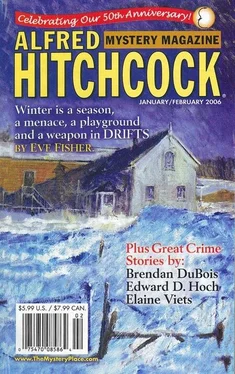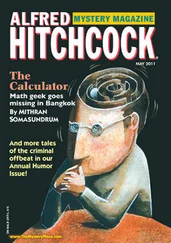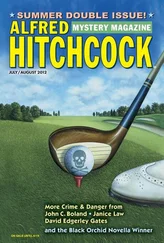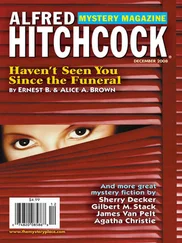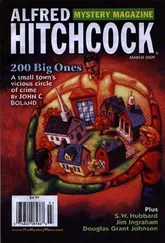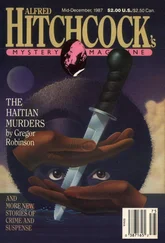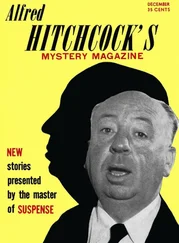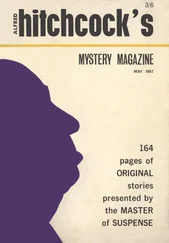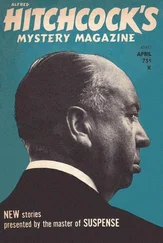John Betancourt - Alfred Hitchcock’s Mystery Magazine. Vol. 51, No. 1 & 2, January/February 2006
Здесь есть возможность читать онлайн «John Betancourt - Alfred Hitchcock’s Mystery Magazine. Vol. 51, No. 1 & 2, January/February 2006» весь текст электронной книги совершенно бесплатно (целиком полную версию без сокращений). В некоторых случаях можно слушать аудио, скачать через торрент в формате fb2 и присутствует краткое содержание. Город: New York, Год выпуска: 2006, Издательство: Dell Magazines/Crosstown Publications, Жанр: Детектив, на английском языке. Описание произведения, (предисловие) а так же отзывы посетителей доступны на портале библиотеки ЛибКат.
- Название:Alfred Hitchcock’s Mystery Magazine. Vol. 51, No. 1 & 2, January/February 2006
- Автор:
- Издательство:Dell Magazines/Crosstown Publications
- Жанр:
- Год:2006
- Город:New York
- ISBN:нет данных
- Рейтинг книги:4 / 5. Голосов: 1
-
Избранное:Добавить в избранное
- Отзывы:
-
Ваша оценка:
- 80
- 1
- 2
- 3
- 4
- 5
Alfred Hitchcock’s Mystery Magazine. Vol. 51, No. 1 & 2, January/February 2006: краткое содержание, описание и аннотация
Предлагаем к чтению аннотацию, описание, краткое содержание или предисловие (зависит от того, что написал сам автор книги «Alfred Hitchcock’s Mystery Magazine. Vol. 51, No. 1 & 2, January/February 2006»). Если вы не нашли необходимую информацию о книге — напишите в комментариях, мы постараемся отыскать её.
Alfred Hitchcock’s Mystery Magazine. Vol. 51, No. 1 & 2, January/February 2006 — читать онлайн бесплатно полную книгу (весь текст) целиком
Ниже представлен текст книги, разбитый по страницам. Система сохранения места последней прочитанной страницы, позволяет с удобством читать онлайн бесплатно книгу «Alfred Hitchcock’s Mystery Magazine. Vol. 51, No. 1 & 2, January/February 2006», без необходимости каждый раз заново искать на чём Вы остановились. Поставьте закладку, и сможете в любой момент перейти на страницу, на которой закончили чтение.
Интервал:
Закладка:
Alfred Hitchcock’s Mystery Magazine. Vol. 51, No. 1 & 2, January/February 2006


Editors Note’s
Season’s Greetings from the staff of AHMM
This year we are celebrating a successful (and terrific) fifty-year publishing run. Although the magazine’s first issue was published in December of 1956, we are taking the whole year of 2006 to showcase some of the finest mystery stories that came out of the magazine. This first issue reprints DeLoris Stanton’s Forbes’s 1957 story “Just Watching.” We think it is as ever biting today as it was when it was first published.
— The Editors
A Tale of Too Much Dickens
by James Powell

It was the best of The New York Times. It was the worst of The New York Times . First Mel Gibbie read of the brutal murder of his associate Lamar Hooper. This he considered the “best” part, for performing Charles Dickens’s “A Christmas Carol” over the holidays had become a very crowded field. The “worst” came in the newspaper’s Arts and Entertainment section. Hollywood’s big animated movie this season was going to be SpongeBob Cratchit’s A SquarePants Christmas. Gibbie already knew Ice-Stravaganza productions planned touring companies of Cheapskates on Skates: the Ebenezer Scrooge Story. And last night, though it was still only November, the Late Show with David Letterman featured Fast Freddy Farmer with the big clock ticking in his two minute version of the Dickens classic, a lickety-split slurry of words punctuated with every “Bah Humbug!” and Tiny Tim’s “God bless us every one” jockeyed around to the end for the big finale.
Gibbie uttered a groan worthy of Jacob Marley’s ghost. Soon, he feared, the world would tire of “A Christmas Carol,” meaning a world tired of Mel Gibbie. He threw the newspaper aside, rose, and stood in front of the gas logs burning in his modest fireplace. Lined up on the mantel were the hand puppets he used in his telling of the story. Since the death of his mother these puppets, the Cratchits in particular, had become his family. He’d told them many times that he only endured his hectic holiday schedule of one-night stands and matinees to keep food on the table and a roof over their heads. Now he told them again.
Then Gibbie got an idea. He and Hooper belonged to the Carolers Club, as the Dickens-doers called themselves. Suppose the murderer was a Caroler too, someone trying to whittle down the competition? (Gibbie was surprised he hadn’t thought of doing that himself. Not that he could ever commit murder. Why? The naked hand puppet of self-reproach knew why. “Because you’re a gutless wonder, Gibbie,” it whispered in his ear.)
Well, gutless wonder or not, maybe Gibbie could do a little whittling too. If a Caroler killed Hooper and Gibbie figured out who, he could tip off the police. That’d be one more competitor out of the way. He sat back down and opened the newspaper.
Hooper had been a Dickens imitator, one of the crowd who wore Victorian outfits and laid on a bit of an English accent for the job. His booking agent came by his shabby Woodside apartment in Queens after Hooper missed a scheduled reading in Stamford the night before. He found his client’s door ajar and the man on the floor bludgeoned to death with the ivory-headed walking stick he used in his act. The cane had a battery-powered light in the head for flagging down taxis. Hooper’d put in a green bulb, and when he did Marley’s ghost or the various spirits of Christmas, he’d hold the head of the cane under his chin and snap on the light to great effect.
Gibbie read the newspaper account of the murder. When he got to the part about the police finding a star made of folded paper at the crime scene he smiled. “Not a star,” he told himself, “a snowflake.” Now he had his man. Bolton Sharpe, a new kid on the Dickens-doers block, carried a colorful stack of origami paper to the podium. As he recited the story, he folded the paper into various props: Scrooge’s nightcap, Marley’s chains and moneyboxes, and of course, Tiny Tim’s crutch. Sharpe’s encore was a dazzling display of high-speed origami folding. Reciting the thirty words the Inuit have for snow, he made a snowflake for each, no two alike, and threw them out into the audience. By season’s end his fingers were thick with adhesive bandages, for paper cuts were a hazard of his business.
As Gibbie reached for the phone to call the police there was a knock on his door. The man standing in the hall displayed a badge. “Mr. Gibbie,” he said, “I’m Lieutenant Mason. I’ve some questions regarding the murder of Lamar Hooper. May I come in?”
Gibbie stepped back in surprise and gestured the man inside.
“I understand you knew the victim,” said Mason.
“So did Bolton Sharpe,” blurted Gibbie.
The detective raised an eyebrow.
The puppeteer quickly explained, “That paper star at the crime scene was an origami snowflake from Sharpe’s act.”
“We know,” nodded Mason. “It had his name written on it. So we looked him up. Now Forensics tells us Hooper was murdered yesterday evening between six and seven. At that time Mr. Sharpe was entertaining the kids at Children’s Hospital. A freebie. A real nice guy, Mr. Sharpe. Real generous with his time. He told us sometimes the audience brought up snowflakes afterwards for him to autograph. Said maybe somebody was out to frame him for Hooper’s murder. And, oh, he mentioned seeing you at one of his performances last year.”
“Just checking out the competition.”
Mason worked his eyebrow again. “Mr. Gibbie, can you tell me where you were yesterday evening between six and seven?”
Blushing, Gibbie jerked his head toward the puppets on the mantel and begged in a whisper, “Can we keep it down? All right, so I was doing a bachelor party. ‘A Christmas with Kinky Carol.’ ”
“Obscene hand puppets?” asked Mason in a disapproving whisper.
“Look,” pleaded Gibbie under his breath, “last month when Billy Napier took a swan dive out his apartment window, Sammy, my booking agent, said if I bought Billy’s stuff from his old lady he’d find me work. Work I need. So I did. I gave the act a try. But it wasn’t up my alley. I didn’t have Billy’s dirty little laugh. So I told Sammy to count me out. He wasn’t happy about that. I only did yesterday’s gig because Sammy’d already booked it.” Gibbie got his appointment calendar and showed it to Mason.
“Okay,” said the policeman, “so while we’re at it, what were you doing on October 11 around eight P.M.?” When Gibbie looked puzzled, Mason explained, “Hooper’s murder has us reconsidering some other cases. We suspect Napier’s swan dive might have had an assist.”
Gibbie thumbed back through the calendar until he found the date. “Okay, here we are. I was trying out this Halloween act. Washington Irving’s ‘The Legend of Sleepy Hollow.’ I’m the Headless Horseman with a coat up over my head. I use this jack-o’-lantern under my arm to narrate the thing. My Bob Cratchit does Ichabod Crane with putty to make his nose long and snipey, and Mrs. Cratchit is plumped out and rouged up to play Katrina Van Tassel.”
Mason looked skeptical.
Читать дальшеИнтервал:
Закладка:
Похожие книги на «Alfred Hitchcock’s Mystery Magazine. Vol. 51, No. 1 & 2, January/February 2006»
Представляем Вашему вниманию похожие книги на «Alfred Hitchcock’s Mystery Magazine. Vol. 51, No. 1 & 2, January/February 2006» списком для выбора. Мы отобрали схожую по названию и смыслу литературу в надежде предоставить читателям больше вариантов отыскать новые, интересные, ещё непрочитанные произведения.
Обсуждение, отзывы о книге «Alfred Hitchcock’s Mystery Magazine. Vol. 51, No. 1 & 2, January/February 2006» и просто собственные мнения читателей. Оставьте ваши комментарии, напишите, что Вы думаете о произведении, его смысле или главных героях. Укажите что конкретно понравилось, а что нет, и почему Вы так считаете.
